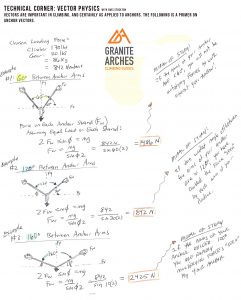Vectors for Climbers
We’ve all heard about vectors. In physics, a vectors is loosely defined as an entity outlining the magnitude and direction of a force. The concept is important because–as we teach our clients–it is important to be aware in our climbing practices of how we multiply or add forces in our favor–or multiply or add forces to work against us. Loosely, one way that we use vectors and forces in our favor is through our belay devices. These devices utilize directional changes to increase the forces/tension on the climbing rope to hold climbers during falls of varying forces.
Unfortunately, we also can arrange our systems to multiply forces against us. You have heard of this when your were told to “keep your angles small” in the arms (or legs as some climbers say) of your anchor. But how much difference does it make? What is the math behind the teaching?
Well let’s start by reviewing the basics. In short, at less than 60 degrees between the arms of your anchor, each arm will likely only “see” or “feel” ~50% of the force applied to the anchor if there are two arms, or ~33% if there are three arms, and so forth. Between 60 and 120 degrees, however, the forces “seen” by each arm of the anchor begin to increase beyond their fair share of the downward force applied to the anchor. That is, at 120 degrees, each arm “sees” the entire applied force–whatever that force may be. In effect you have now doubled the force applied to your anchor simply by the unfortunate arrangement of the anchor components. Angles beyond 120 degrees quickly become more dangerous.
The simplified math behind these angles are outlined in the image below in three examples. Pay special attention to the 160 degree angle . . . simply applying a climber’s body weight plus his/her gear generates 2425 Newtons of force on each anchor arm, or 4850 Newtons of force total. That’s almost 5 kN which approaches some carabiner’s open gate strength. And that’s just the force of body weight.

